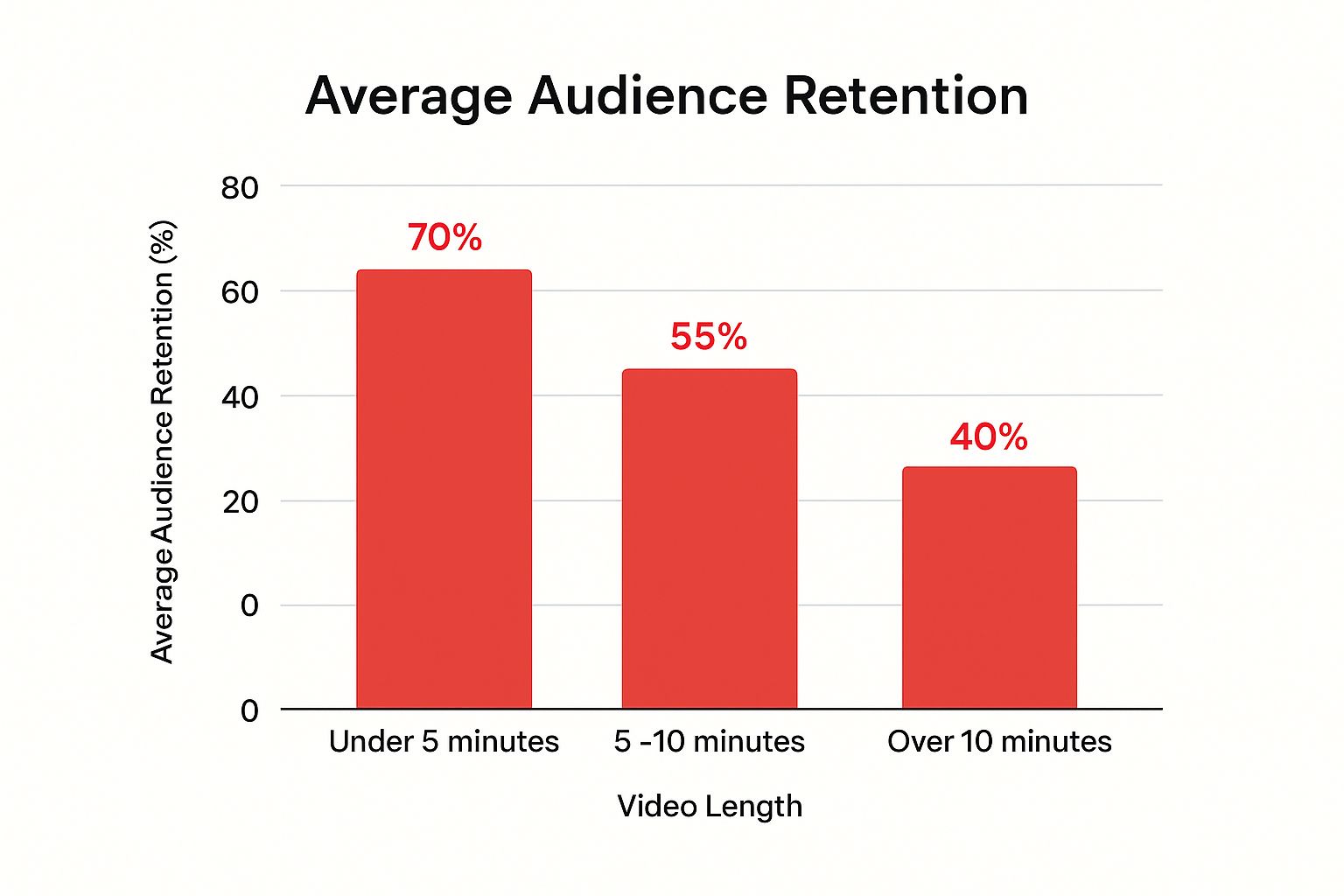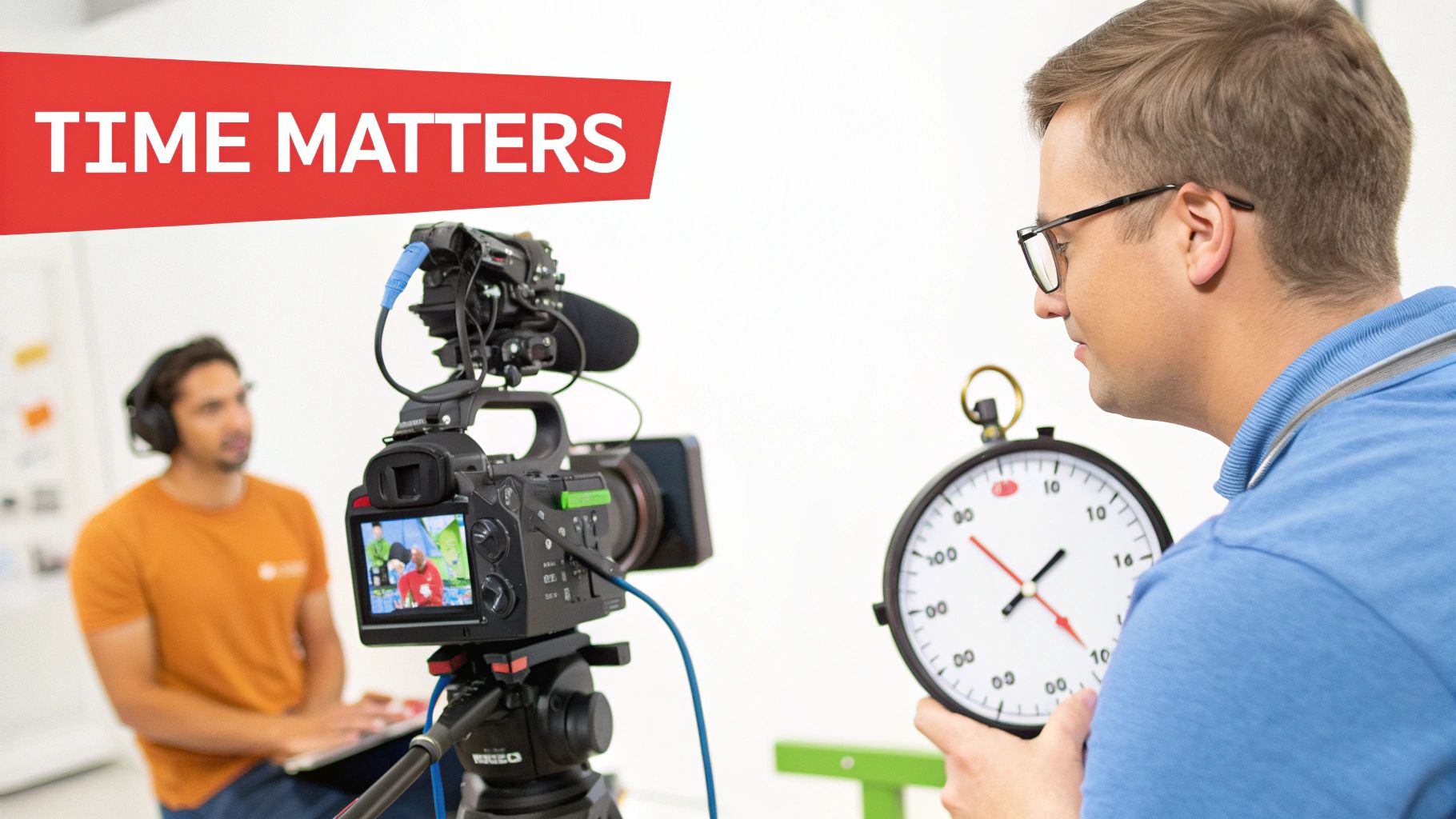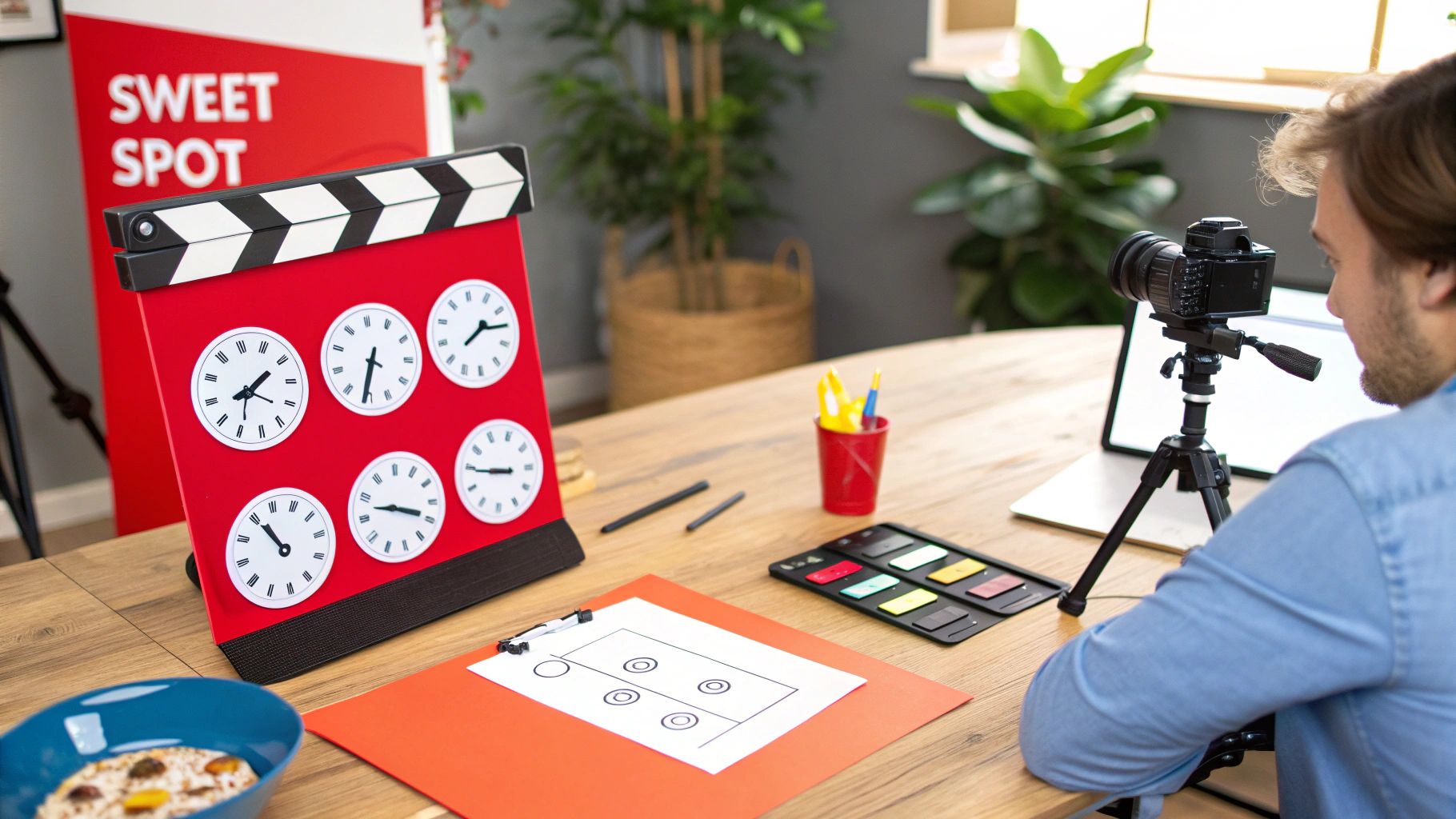Let's get one thing straight: there’s no single magic number for the perfect YouTube video length. But if you're looking for a solid rule of thumb, the sweet spot for most videos lands somewhere between 7 and 15 minutes.
Why that range? It's long enough to rack up serious watch time and, crucially, it qualifies you for mid-roll ads. Both of these are huge signals to the YouTube algorithm that your content is worth promoting.
Your Quick Guide to Video Length on YouTube
While the 7-15 minute window is a great starting point, the real perfect length is always determined by your content's value and what your audience expects from you. Trying to stretch a video just to hit a certain number is a recipe for disaster. It kills your audience retention, which is one of the most important metrics on the platform.
Think of it this way: a short, punchy video that keeps viewers glued to the screen will always beat a long, rambling one that makes them click away. The goal is to match the length to the topic. A quick tip might only need three minutes. A deep-dive tutorial? That could easily justify 20 minutes or more. Deliver the goods, cut the fluff.
Finding Your Content's Sweet Spot
To get a better feel for this, let's look at the bigger picture. The average length of a video across all of YouTube is about 11.7 minutes. But that number changes wildly depending on the niche. Gaming videos, for instance, average nearly 25 minutes, while music videos are closer to 7 minutes. This just goes to show how much your content style shapes what viewers will stick around for. You can learn more by checking out current YouTube usage statistics.
This chart here really drives the point home, showing how average audience retention changes as videos get longer.

As you can see, shorter videos are champs at holding a high percentage of their audience. But don't count out longer videos—they can generate way more total watch time even if the retention percentage is a bit lower. It’s a classic balancing act.
Optimal YouTube Video Length by Content Type
To help you get started, I've put together a quick reference table. Think of this as a cheat sheet for matching common video formats with the lengths that tend to perform best. It's a great way to make sure your content strategy is built on what actually works.
| Video Type | Recommended Length | Primary Goal |
|---|---|---|
| Tutorials & How-To Guides | 7-15 minutes | Provide comprehensive, step-by-step instructions and build watch time. |
| Vlogs & Entertainment | 10-18 minutes | Foster a deeper connection through engaging storytelling and personality. |
| Product Reviews | 5-10 minutes | Deliver concise, valuable information quickly to help viewer decision-making. |
| News & Commentary | 8-12 minutes | Offer timely analysis while being long enough to enable mid-roll ads. |
Use this table as your guide, but always remember to listen to your own analytics. Your audience will tell you what they want—you just have to pay attention.
Why Watch Time Is the Most Important YouTube Metric

Let's imagine YouTube is a restaurant. The owner's main goal isn't just getting people through the door. It's making sure they sit down, enjoy their meal, and maybe even stick around for dessert. The longer they stay and the happier they are, the more successful the restaurant is.
On YouTube, Watch Time is that key measure of success. It’s the total number of minutes people have spent watching your videos, and it sends a powerful signal to the algorithm. High watch time basically tells YouTube, "Hey, people are loving this. We should show it to more people."
This is why thinking about video length is so important. A longer video, even if people don't watch it all the way through, can rack up more total Watch Time than a shorter video that gets 100% retention. It’s a game of minutes.
The Watch Time Formula Explained
The math behind this is actually pretty simple. It all comes down to the relationship between a few key stats:
- Average View Duration (AVD): This is the average length of time someone watches your video.
- Views: The total number of times your video has been played.
- Watch Time: You get this by multiplying your Views by your AVD.
Let's look at an example. Say you have a slick, 3-minute video that everyone watches from start to finish. That’s great! You earn three minutes of Watch Time for every single view.
But what if you also have a 10-minute video, and on average, people only watch half of it? That might sound like a lower retention rate, but that video is still earning five minutes of Watch Time per view.
When it comes down to it, the algorithm often favors the five minutes from the longer video over the three minutes from the shorter one. Why? Because that longer video did a better job of keeping someone on the platform, which is YouTube's number one business goal.
This simple concept should be at the core of your content strategy. The goal isn't just to hit a specific video length. It's to create something so compelling that people want to spend their time with it, whether it's five minutes or twenty. The "ideal" length is whatever maximizes that viewer investment.
Aligning Your Goals with YouTube's Goals
When you start focusing on Watch Time, everything else falls into place. You can stop obsessing over every little metric like clicks, shares, or comments and just focus on the one thing that truly matters: holding people's attention.
By prioritizing Watch Time, you’re putting your channel's goals in perfect harmony with YouTube's.
This is absolutely crucial if you're trying to get monetized. A key requirement for the YouTube Partner Program is hitting 4,000 hours of public watch time. If you’re trying to figure out how to get there, you can learn more about the fastest way to get 4000 watch hours on YouTube and see the strategies successful creators use.
Ultimately, making videos that generate high Watch Time isn't just about feeding the algorithm. It's how you build a real, sustainable channel with an audience that keeps coming back for more.
How the YouTube Algorithm Really Sees Your Video Length

Let's clear up a common myth right away: YouTube doesn't have a favorite video length. The algorithm isn't sitting there with a stopwatch, giving gold stars to 10-minute videos and ignoring 3-minute ones.
The truth is much more practical. The algorithm cares about the result of your video's length, not the number itself. Its main job is to keep people watching, and a video that holds someone's attention for a long time is incredibly valuable to the platform. Think about it—more watch time means more chances to show ads and keep users on YouTube.
So, while the algorithm doesn't directly reward a video just for being long, it absolutely rewards the high total watch time and strong audience retention that a well-made longer video can deliver. Length is simply the potential; engagement is the proof.
The Magic of the 8-Minute Mark
While there's no single "perfect" length, the 8-minute mark is a huge milestone for any creator. This isn't some secret algorithmic preference; it's a straight-up business rule set by YouTube. Once your video is longer than eight minutes, you can place multiple "mid-roll" ads throughout it.
This changes everything. A video with more ad slots can make more money for both you and YouTube. From the platform's perspective, an engaging video that's over 8 minutes is the golden goose. It’s a piece of content that keeps people happy and generates more revenue.
The algorithm is built to promote videos that are good for business. The 8-minute mark makes your video a better business asset, giving the algorithm a financial reason to push it—as long as people are actually watching.
This financial incentive is a big reason why you often see videos in this range getting a little extra algorithmic love. It's not about the runtime; it's about the revenue potential that runtime unlocks.
Length Is Only Half the Story
Simply stretching your video past the 8-minute mark won't trick the system. The algorithm is way too smart for that. It knows the difference between a gripping 9-minute story and a 5-minute video padded with four minutes of fluff.
This is where your viewer satisfaction metrics become critical. The algorithm looks at length alongside engagement signals to decide if your video is any good. It's paying close attention to things like:
- Audience Retention: What percentage of your video do people watch on average? A massive drop-off early on is a huge red flag, especially on a longer video.
- Average View Duration: How many minutes does the average viewer stick around? This directly feeds into your total watch time.
- Engagement Signals: Don't forget the basics! Likes, comments, and shares are clear signs that your content is making an impact and starting conversations.
At the end of the day, your goal isn't just to make long videos. It's to make videos that are worth watching for a longer time. The ideal YouTube video length is the one that tells your story completely, respects the viewer's time, and delivers so much value that they stick around. When you nail that, the algorithm will notice.
Matching Your Video Length to Your Content Style

General advice on video length is a decent starting point, but the real magic happens when you tailor your runtime to your specific content style. There’s no single “perfect” YouTube video length. It’s a moving target that changes based on what you’re making and what your audience has come to expect.
Trying to squeeze a complex tutorial into five minutes is a recipe for frustration, just like stretching a simple product review to fifteen minutes will have viewers clicking away.
Think of it like packing for a trip. You wouldn't try to cram two weeks' worth of clothes into a tiny carry-on, and you wouldn't lug a giant suitcase for an overnight stay. Your video's length is the container, and it needs to be the right size for the content inside. Every format has its own natural rhythm, and respecting that is the key to keeping people watching.
Tutorials and Educational Content
When someone searches for a "how-to" video, they're on a mission. They want a complete solution, and cutting corners just to hit a shorter runtime will only annoy them. This is one area where longer videos don't just work—they're often exactly what the audience is looking for.
For things like detailed DIY projects, software walkthroughs, or deep-dive lessons, aiming for 12 to 18 minutes is a great sweet spot. This gives you enough breathing room to cover every step clearly, anticipate common problems, and deliver genuine value without making viewers feel rushed. A shorter video might get the click, but the comprehensive one earns the watch time and the subscriber.
With educational content, a viewer's main goal is to learn something. If you can successfully teach them a skill, they'll happily give you their time. This makes longer videos incredibly effective for building authority and racking up watch hours.
Commentary and News Analysis
Commentary and news videos play by a different set of rules. Here, speed and sharp insights matter more than covering every single detail. You need to get your take out there while the topic is still hot.
A runtime between 8 and 12 minutes is a solid strategy. It feels substantial enough to be authoritative and comfortably clears the 8-minute threshold for placing mid-roll ads. More importantly, it forces you to get straight to the point, deliver your analysis, and wrap up before you lose momentum. The key here is pacing—the video should feel packed with information, not padded with filler.
Vlogs and Product Reviews
Vlogs and product reviews are all about personality and trust. People tune in to see you or to get your honest opinion on something they want to buy.
- Vlogs: These often do well in the 10 to 18-minute range. That length gives you the space to tell a real story, take your viewers on a journey, and forge a much stronger personal connection.
- Product Reviews: These need to be tighter, usually landing between 5 and 10 minutes. Viewers want the essentials—the good, the bad, and your final verdict—without a lot of fluff.
- Niche Content: Some genres have their own unspoken rules. When you're thinking about your video length, it helps to look at how specific communities, like in the case of understanding niche content like ASMR on YouTube, have established their own unique expectations for content and format.
When you start tailoring your video's length to its purpose, you're no longer just following generic advice. You're building a smart content strategy. You’re giving your viewers exactly what they came for, which builds loyalty and sends a powerful signal to the algorithm that you know how to keep your audience happy.
Using YouTube Shorts for Audience Growth
While we've been focused on finding that perfect length for your main videos, it's time to talk about YouTube Shorts. They play by a completely different set of rules. Think of Shorts not as tiny versions of your regular content, but as high-energy trailers for your entire channel. They are built for one thing above all else: rapid discovery.
Shorts aren't the place to rack up huge watch-time minutes or dive deep into a topic. Their real power is in snagging the attention of new people who are just endlessly scrolling. A great Short can introduce your brand, personality, and style to a potential subscriber in just a few seconds, making it an incredible tool for getting new people in the door.
Maximizing Impact in Minimal Time
The secret to a killer Short is to deliver value and a strong hook instantly. YouTube lets you make them up to three minutes long, but honestly, the most effective ones are way shorter. The data consistently points to a sweet spot between 15 and 35 seconds for keeping viewers hooked. Why? Because the Shorts feed is a lightning-fast world where people make snap judgments. You can find more insights on what makes for a great video length on zelios.agency.
Your mission is to be memorable and intriguing enough to make someone tap through to your channel. Don't try to squeeze a full-blown tutorial into a Short. Instead, create content that’s tailor-made for that quick-hit format.
Think of it this way: Your long-form video is the main course—it's where you provide deep value and build a real relationship. A YouTube Short is the free sample that gets people interested enough to sit down for the full meal.
Strategic Ways to Use YouTube Shorts
Weaving Shorts into your content plan doesn't have to be a huge headache. They should support your main videos, not compete with them.
Here are a few practical ways to put them to work:
- Announce New Videos: Post a quick, exciting teaser for an upcoming long-form video. It's a fantastic way to build some hype.
- Share Behind-the-Scenes Clips: Show your audience a peek into how you create. This stuff builds a much stronger community connection.
- Repurpose Key Moments: Grab a powerful quote, a funny outtake, or a killer tip from a longer video and turn it into a Short.
- Test New Content Ideas: Got an idea you're unsure about? Make a Short on it. You can quickly see if your audience is interested before you invest hours into a full-length video.
When you use Shorts like this, you create a powerful growth engine. They bring in fresh eyeballs, and your main content gives those new viewers a compelling reason to stick around and subscribe. And if you're wondering about making money from them, be sure to check out our guide on whether you can monetize YouTube Shorts to round out your strategy.
How to Find Your Channel's Perfect Video Length
Stop guessing. If you want to know the perfect length for your YouTube videos, you need to stop chasing trends and start looking at your own data. The answer isn't a magic number floating around on the internet; it's hiding inside your channel's analytics.
Your YouTube Analytics dashboard holds all the clues. Once you learn how to read it, you can see exactly what your audience loves and what makes them click away. It's time to let the numbers do the talking.
Decode Your Audience Retention Graphs
The most important tool for this job is your Audience Retention graph. You'll find it in the "Engagement" tab for every video you've uploaded. This graph is a second-by-second breakdown of viewer engagement, showing you the exact moments people get bored and leave.
Start looking for patterns across your most popular videos. Is there a big drop-off right after your intro? Do people bail during a specific segment you always include? These graphs tell you a story about your pacing and whether you're getting to the point fast enough.
Think of a sharp, sudden dip in your retention graph as a viewer literally saying, "Okay, I'm done." Pinpointing these moments is the first step toward creating videos that hold attention from start to finish.
Analyze Your Top-Performing Videos
Next, pull up a list of your top 10 videos by watch time—not just view count. Watch time is the metric that truly tells you which videos kept people hooked the longest. For each one, write down its length, topic, and format.
A pattern will almost certainly jump out at you. Maybe you'll notice that all your highest-retention videos are between 9 and 12 minutes long. Or perhaps you'll see that your in-depth tutorials that run over 15 minutes are the ones that really keep people watching. This is your channel's sweet spot, backed by real viewer behavior. Digging into this is much easier with the right software, which we cover in our guide to the top YouTube analytics tools for channel growth.
Use Editing to Hold Attention Longer
Once you have a target length in mind, it’s all about making every single second count. Smart editing is what separates a good video from a great one.
- Pattern Interrupts: Break up long stretches of you just talking to the camera. Use quick zooms, pop-up text, sound effects, or relevant B-roll to reset your viewer's attention span.
- Chapter Markers: Always add chapters to your videos. They let viewers skip to the parts they care about most, which encourages them to stick around longer instead of just leaving.
- A Ruthless Edit: Be brutal with your cuts. Get rid of every "um," long pause, and rambling thought. If a sentence doesn't add direct value, it has to go.
These tactics are even more critical if you're using your channel for business. For example, great Shopify influencer marketing strategies are built on creating content that not only engages but also inspires action. By letting your own data guide you, you can stop guessing and start creating videos that are perfectly tuned to your audience.
Got Questions About YouTube Video Length? We've Got Answers.
Let's clear the air and tackle some of the biggest questions and myths floating around about how long your videos should be. Getting these straight will give you a ton of clarity and help you focus on what actually moves the needle.
Should I Split a Long Video Into Two Parts?
My gut reaction? Almost always no. If you’ve got a single, solid topic, you want to keep it all in one powerhouse video. Why? Because this concentrates all your watch time into one asset, and that's exactly what the YouTube algorithm loves to see.
Think of it like a good movie. Chopping it in half just invites people to wander off during the intermission. You lose all that precious momentum.
The only time splitting a video makes sense is if each part can truly stand on its own as a complete, valuable piece of content. Each video needs to satisfy a specific search or solve a distinct problem for the viewer.
Is an 8-Minute Video the Magic Ticket to More Views?
Absolutely not. Hitting that 8-minute mark isn't some secret handshake that gets you into the viral video club. All it does is unlock the option to place more ads (mid-rolls) in your video. This makes it a potentially more profitable video for YouTube, but only if people are actually sticking around to watch it.
A rambling, 9-minute video that people click away from after two minutes is a total dud. It will get crushed by a super-engaging 7-minute video that people watch all the way through. Quality and audience retention will always be king.
The right video length isn't about gaming the system. It’s about creating something so good that you earn the viewer's time.
How Can I Figure Out What My Audience Actually Wants to Watch?
Your best friend here is your own YouTube Analytics. Seriously, it's a goldmine. Head over to the "Engagement" tab for any of your videos and start digging into the audience retention graphs. These charts are incredible because they show you, second by second, exactly where your viewers are losing interest and clicking away.
Start looking for patterns across your best-performing videos:
- Do people consistently bail at the same point, like during your intro?
- Are your most popular videos all around a similar length?
- Which types of topics keep people glued to the screen the longest?
Don't be afraid to experiment. Try out different formats and lengths, and then dive back into the data. The numbers don't lie—they'll tell you exactly what your audience is hungry for.
Ready to skip the grind and start earning immediately? MonetizedProfiles offers fully approved YouTube accounts that are ready to generate ad revenue from day one. Check out our selection of monetized channels available for purchase.









